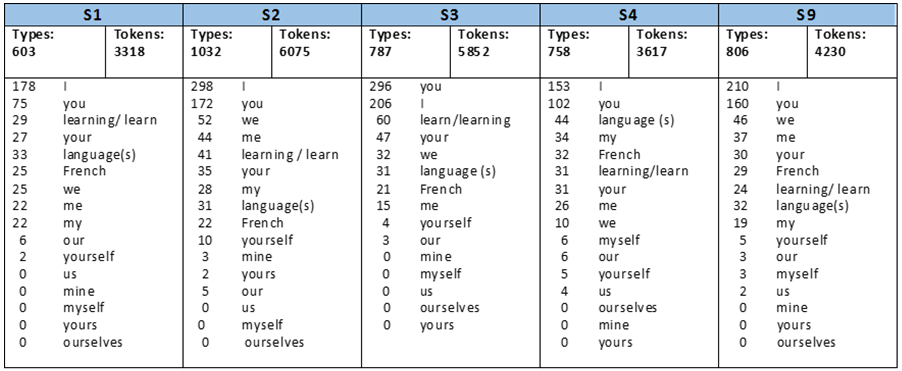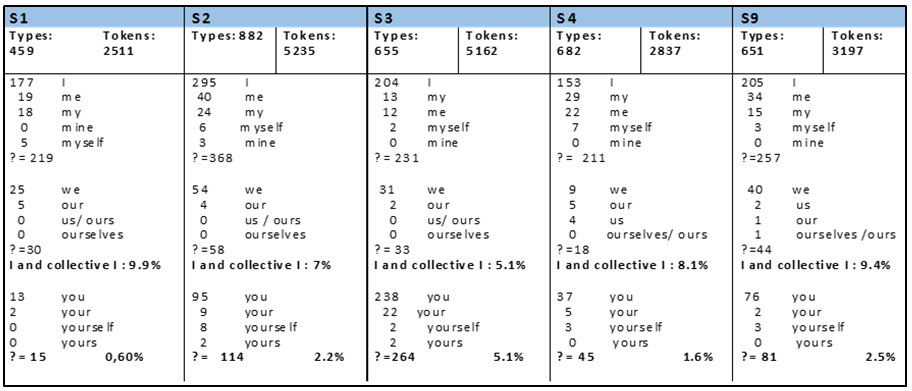Innovating in teaching adult learners? Working on the foreign language learners’ emotional journey
Fabienne BAIDER, University of Cyprus, Cyprus
Maria KOUNOUNI, University of Cyprus, Cyprus
Résumé
Même si les adultes représentent une partie non négligeable des apprenants, en particulier avec les mouvements de migrations actuels, peu d’études leur ont été consacrées (Norton-Pierce, 2000, Coffey, 2010). Il est donc important de combler cette lacune afin de mieux comprendre leurs besoins et d’adapter nos stratégies d’enseignement. Dans cette étude nous essayons de comprendre les émotions ressenties au cours de l’expérience d’apprentissage de FLE par des adultes et comment adapter nos stratégies d’enseignement dans un tel contexte pédagogique (Norton-Pierce, 2013). Pour ce faire nous travaillons sur des biographies langagières orales et sur la notion de subjectivité. Notre analyse est ancrée dans le concept d’ « engagement » (Coffey, 2010) et de rich point tel que proposé par Agard (1996). Notre méthodologie comprend la linguistique de corpus et l’analyse du discours. Parmi nos résultats figurent des différences intéressantes relevées dans certaines interviews, différences qui peuvent être expliquées en partie par des contextes sociaux et psychologiques. Cette dimension personnelle peut éventuellement être connue avant le début du processus d’apprentissage par une interview avec les apprenants et ainsi aider à l’apprentissage.
Apprenants adultes - Biographies langagières - Émotions - FLE - Linguistique de corpus - Rich point
Abstract
Although they are a non-negligible part of the learning public, especially with present day migrations movements, few studies have been devoted to the study of adults learning a foreign language (Norton-Pierce, 2000, Coffey, 2010). It is therefore important to fill this void and understand better their needs in order to adapt our teaching strategies. This article focuses on the role of emotions and emotional literacy in such a pedagogical context (Norton-Pierce, 2013) and on the way understanding the affects during the learning experience can help our teaching strategies. Our data consist of spoken biographies and our analysis is anchored in the concept of ‘engagement’ (Coffey, 2010, 2015) as well as rich point (Agard, 1996). Our methodology includes corpus linguistics and discourse analysis. Some of the results show that striking differences in some reflexive interviews can be explained partially from social and psychological contexts. These aspects can be known before the start of the learning process and therefore can enhance an engagement on the part of the learners from the beginning of the classes.
Adult learners - Corpus linguistics - Emotions - FLL - Language biographies - Rich point
INTRODUCTION
Although they are a non-negligible part of the learning public, adults learning a foreign language by choice and not by obligation have been the topic of few studies (Norton-Pierce, 2000). It is therefore important to fill this void, and to understand better their needs in order to adapt our teaching strategies. This article presents the second part of a longitudinal study focused on the role of emotions and subjectivity in such a pedagogical context (Norton-Pierce, 2013). Our data consist of individual interviews focused on the questions which arose from the reflexive written texts of eight participants, collected over a year. The quantitative as well as the qualitative analysis of these spoken data is the topic of this article. We first introduce the field in which we are working (language biographies), our theoretical framework, mainly the concepts of salience (Giora, 2003, Kecskes, 2013), commitment (Coffey, 2010) and rich point (Agar, 1994, Mangenot, 2007), and our methodology with corpus linguistics (Sinclair, 2004) and discourse analysis (Bednarek, 2008, Vasquez 2004). Our second section summarizes the findings of our first study which was devoted to the written texts and to the questions we wanted to investigate with our spoken data. The last section analyses quantitatively the spoken data for the eight subjects and qualitatively for two subjects, S1 and S3. These two subjects presented striking results as far as the written data are concerned as we explained in our second section.
1. INVESTIGATING LANGUAGE BIOGRAPHIES
1.1. Studying a fluid Self, exploring ‘engagement’
At the crossroads of sociolinguistics and language teaching (Molinié, 2013, p.11), the study of reflexive texts about learning experience has been considered as a useful means of exploring the psychological, emotional and intellectual journey which learners go through when learning a language (foreign or second). This field has known a significant growth in France since 2000. The first studies dating back to the 90’s (Lahire, 1990, Boutet, 1999 among others) focused on the learners’ representations of languages. In English-speaking countries, the beginning of such an interest in the interface of affects and the learning process started in the 80’s, notably with Horwitz’s first studies in 1985 devoted to anxiety. Norton-Pierce (1995, 1997, 2000 inter alia), however, is the main reference as far as taking into account the social dimension of learning a language. In particular, she underlined the role of the social context in the construction of the learner’s identity and in the experience of learning (Lave and Wenger, 1991), as well as the role of the cultural, economic and symbolic capital tied to the target language since any language embodies the power relations structuring that capital (Bourdieu, 1977):
As well, learners are encouraged to reflect critically on their engagement with target language speakers. That is, learners might investigate the conditions under which they interact with target language speakers, how and why such interactions take place, and what results follow such interactions. In this way, learners will develop insight into the way in which opportunities to speak are socially constructed, and how social relations of power are implicated in the process of social interaction. (Norton, 2013: 189, our italics)
Studying a spoken or written biography, that is to say a narrative in the first person, has then to take into consideration how the Self, and the relationship to the language, to the teacher and to the other participants are (de)-constructed along with which social interactions are taking place (Dörnyei, 2009, Davies and Harre, 1990). The positioning taken in those interactions is also fluid since it depends on the type of interaction, on the culture, gender, age, status, of the participants, etc. (cf. Hymes’ model SPEAKING).
Therefore the commitment which adult learners have in studying the target language must be understood in relation to the multiple, changing, and contradictory identities by choice of language speakers (Norton ibid.), among different parameters. Notions of commitment and investment, however, do not describe the depth of transformation undergone when one learns to live through a new language; this is why we chose to use the notion of ‘engagement’ coined by Coffey (2010) in his research on adults who learn a language by choice. This choice adopts the point of view of considering acquiring a new language as giving a new meaning to the world, to things, to beings, and thus, creating a different relationship with the world, things, beings (Kramsch 2006). Because of this intense relationship and the transformation of the Self, we chose to use the notion of ‘engagement.’ We understand learning a language as an identity positioning and therefore we focus on the dimension of subjectivity and intersubjectivity in our methodology and inquiry (cf. section 2).
Reflexive texts are then crucial not only to understand the learning process but also to apprehend the story of fluid identities (Gee, 2000, p.101-107). They are narratives and should be explored as such, employing interpretative tools such as the ones used in discourse analysis (cf. Section 2).
1.2. The notion of ‘rich point’
As mentioned previously, in the learning language process, new meanings are given to the world, beings, experiences and things; thereby, a different relation to the world and to beings emerges. Our premises are that emotions are central to this meaning making process and this centrality of emotions leads us to the concept of ‘rich point’ (Agar, 1994, Mangenot, 2007). As explained by Mangenot, when learning a language culture, we live moments of surprises (good or bad); these moments of surprises emerge as well when trying to understand the differences which we encounter between cultures and between languages. These moments of awe or surprise are the opportunity for discussions and discoveries as much about the Other as about the Self. Indeed while striving to understand these differences we reflect on our own language and this process makes us able to build a bridge between ourselves and the Other; this emotional moment is transformed as well into a cognitive process of understanding. It has been described as ‘rich points’ (Agar, 1996). In our first study we reappropriated the notion of rich point for our purpose as teachers-ethnographers. When reading the biographies we found elements of surprises as far as the language learning process is concerned, which include:
– Signs of differences compared with what we knew or what we expected from the learners;
– Signs of differences between learners in their autobiographies.
We then tried to explain these moments and we tested our hypothesis with the learners themselves in order to understand how they can be explored to further the engagement of the learners:
– By finding out whether different learning or teaching strategies would be more adequate than the ones usually followed;
– By making proposals of situated learning and teaching according to our findings.
Indeed both the notions of rich point and engagement were proven to be crucial in our analysis of written biographies as the next section explains.
2. METHODOLOGY, DATA AND RESULTS OF FIRST STUDY (WRITTEN REFLEXIVE TEXTS)
Over the period of one year we collected reflexive texts of adult learners after specific class activities, such as debates, grammar exercises, book presentations, etc. (cf. Baider and Kounouni, 2015 for details). This section explains in detail the methodology we used to explore the written data given that we applied the same one for the spoken data. We also present the results which are the most relevant to understand our spoken data results.
2.1. Methodology
A blind reading was carried out by studying data without knowing the participants at all. For this phase we used a Corpus Linguistics approach (Sinclair, 2004) on the written data with the aim of finding and studying some specific frequencies of lexical items. The most frequent lexical units were then considered as the most salient words. Indeed analysing salient lexical units may provide insights into the levels of cognitive salience (Kecskes, 2013, p.177). We also observed the collocates and co-occurrences of these salient lexical items in order to identify the semantic preference of such lexical data (Partington, 2004, Bednarek, 2008).We understand semantic preference as the most frequent lexical field which collocates with one lexical item, for instance here which lexical field would be typically found when using the words learning and language. We then went back to the transcripts of the texts to study the contextual use of these salient units. We used the concept of ‘semantic prosody’ for our discourse analysis (cf. Vasquez, 2014, Bednarek, 2008). Semantic prosody is, for us, the axiological values of the context (a positive, negative, neutral polarity of the discourse). For example if the paradigm of fear is found we analyse it as a negative semantic prosody; if the paradigm of joy is found we analyse the semantic prosody as positive [1].
In order to discover the nature of each participant’s engagement in the learning process we focused on the following parameters:
– The markers of subjectivity: the frequencies and contextual uses of I and we as well as the frequencies and the use of the paradigm of the (real or imagined ) interlocutor you;
– The contextual uses of the paradigms of the words learning and language in different self-reflexive activities;
– The frequencies and uses of the paradigms of emotion words feel, enjoy, hate/dislike and the use of words expressing subjectivity (such as adverbs).
2.2. Corpus and participants
We established our data in two research phases. First we carried out a longitudinal research from October 2014 until May 2015. Then after having drawn some hypotheses from our data we carried out an interview phase (September 2015).
Our participants consisted of a group of 11 adults, but we will be focusing on three of them, one man and two women whom we called (S1, S2, S3). Their ages varied from 19 to 70 years old. The participants were studying French in order to achieve Levels B1, B2 or C1 of the Common European Framework of Reference for Languages. A more detailed description of S1, S2 and S3 is given in the table below (Table 1).
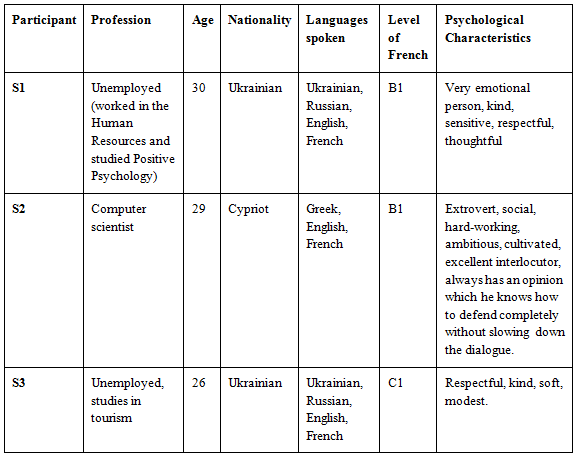
Table 1– Description of participants [2] [3]
2.3. Analysis and results for the written data
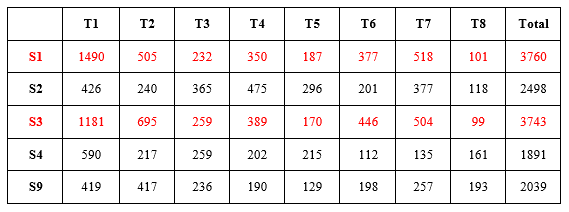
Table 2 - Number of words in every text (T) by S1, S2, S3, S4, S9 [4]
The total of words can be seen in Table 2.Two participants (in red) are remarkable by the volume of words they employed, but as well as by their use of the pronouns you and I all along the activities [5].
We identified a larger proportion of the paradigm I (myself, etc.) in the texts of S1 and S3 who also wrote the longer texts. This could signal a personal dimension attributed to the learning experience: the personal pronouns and the length of the texts may point at a desire to express oneself, to share one’s experience, to reach to the Other, etc. In contrast, S2 for example showed a low frequency of both paradigms I and you and an average length of texts. Therefore we could infer that S2 is not engaged in the same way and that reaching to the Other may be less easy or less important for S2 as a learner or as a person. We are fully aware that the cause of the difference may pertain to one’s personal style, cultural way of expressing oneself, or a different personality. However this difference is for us, who are trying to understand the learners, a sign to take into account.
Similarly the semantic preferences for the word learning in the data of S1, S3 are structured according to the people field (teacher, classmates, etc.) and the communication field (collaboration, have a dialogue, etc.). In contrast, in S2 data, the semantic preferences of the word learning were dominated by abstract nouns such as time, experience, capabilities and words expressing the results of the learning process, such as competence, results.
Finally the study of emotion verbs (feel, hate, like, enjoy, etc.) strengthened the results obtained related to pronoun usage. The list of the most frequent verbs indicates that for S1 and S3 the verb feel is one of most notable while it is practically non-existent in the other texts. We noted the frequency of the verbs enjoy, dislike and hate. These verbs are not used much, but are still more frequent in S1 and S3 data. This means that we have on the one hand a sub-group S1/S3 very focused on the expression of the Self and expressing freely emotions. The sub-group S2/S4 on the other hand is least focused on the above parameters. S9 is situated in the middle, in a median zone. We can correlate the use of emotion verbs with the frequencies of intersubjective pronouns as signs of a specific engagement in the process of learning.
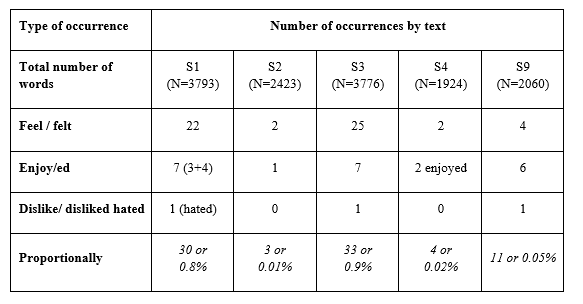
Table 3 - Comparison of the use of the most frequent verbs
Given the convergence of the characteristics in our written data and the fact that they were collected in a longitudinal study, we could infer that:
– a more relational process describes the engagement of S1 and S3 in their learning experience. This engagement is characterized by a higher frequency of personal pronouns, a higher frequency of lexical items describing social communication and a higher frequency of emotion verbs;
– a more result oriented process describes the engagement of S2 and S4 in the learning experience. This relationship is characterized by a lower frequency of personal pronouns, a higher frequency of lexical items describing acquisition of competences and a lower frequency of emotion verbs.
We thus concluded that different activities could be favoured to trigger higher engagement in learners: debates, dialogues, role play would be welcome for S1 and S3 and would stimulate their interest and their learning. Projects and book presentations would be preferred activities for S2 and S4. According to the teacher-researcher, the conclusion regarding S2’s and S4’s preferred activities made by the other researcher after her blind reading corresponds to her own experience with the learners. Indeed, the teacher-researcher knows that S2 and S4 love and enjoy debating at length on almost any topic. The tentative conclusion could then be as follows: although all four subjects love speaking activities, S1 and S3 appreciate more the experience of sharing and exchanging during conversations (the activities are enjoyed for their own sake) whereas S2 and S4 seem to focus on the target to impress the audience while getting better and better in speaking the foreign language (i.e. there is a telic function of the activities).
3. METHODOLOGY, DATA AND RESULTS OF THE SECOND PHASE OF THE RESEARCH
Given these results, we wanted to investigate whether what we had hypothesized with written texts would also be verified by an interview. Interviews have been known to be used in innovative pedagogy methods in order to tailor teaching strategies to the learners’ styles.
3.1. Methodology and data
The interviews were conducted in English, a language imposed by the researcher as it was the language that all the participants mastered the best. The number of words used by every participant and the duration of each interview are presented in Table 4. Forty questions were asked. In a general way, the researchers tried to see whether the participants were going to give similar answers in their interviews and in their written texts as to apply the triangulation principle of data (Wodak, 2009).

Table 4 - Total number of words and minutes in the interview by participant
Even though the researchers considered that what had been found in the written data was unique to each participant, the same questions were asked of all the participants during the interviews. However in the participants’ answers, which are long and explanatory, differences were perceived and the researchers elaborated on the differences on the spot by asking supplementary questions; these questions were not written because they were spontaneous and had not been planned. They were transcribed however, as well as what was replied to them.
In order to analyse the data we used again a blind reading as in the first study i.e. we observed only frequencies and collocates. Our focus was again the expression of intersubjectivity (use of pronouns, frequencies and collocates of the pronouns, as well as the semantic preferences of the lexical items learning and language). We went back to the passage where these pronouns and lexical items are found so as to understand the semantic prosody.
3.2. Frequencies and semantic preferences
Frequencies
In Table 5 we show the general results of the frequencies of occurrence of pronouns and of the words language(s) and learning for the five participants.
Table 5 - Frequencies of occurrence of pronouns and the words language(s) and learning
Table 6 shows more specifically the paradigms of pronouns I and you. It can be observed that if in the written data we had noted a much higher frequency of personal pronouns for S1 and S3, in the spoken data, these intersubjective pronouns are quite even among speakers. Hence there is no difference in personal or cultural style as far as conversations are concerned.
Table 6 - Uses of paradigms of pronouns I and you
However, and we could mention here a rich point for the researchers, we had the surprise to see that S1 was producing the longest texts in the written data (3760 words) while in the spoken data S1 spoke the least (2351). Secondly and proportionally, the you paradigm shows the lowest score for S1 (0,6%) whereas again in the written data it was the opposite: S1 had the highest score for both pronouns (9,8%).
In contrast, S3 had scores very similar to S1, as far as frequencies of pronouns was concerned, and her data are consistent with the previous written data: same high volume of words, same high presence of the you pronoun, for instance. Furthermore when the much used expression you know in S1 data (57 occurrences) is subtracted from the uses of the you pronoun, the total number of you stays the highest among all results (181, 3.5%). As in the written data, S3 seems to be the most focused on the Other (imaginary or real) among all participants.
Two questions then arise from these spoken data:
– S1 seems detached from any engagement during an interview, whereas S3 seems at ease with both types of assignments: why? How can we understand the difference between them?
– if we conclude that S1 and S3 do not live in the same way their relational and emotional engagement to language learning, what does it mean for us as their teachers?
We then investigated the semantic preferences of the pronouns and the lexical items, more particularly for S1 and S3 in order to find some clues to the above questions.
Semantic Preference
The semantic preferences of both S1 and S3 for the words language and learning was investigated.
For S1 the collocates of language and learning describe the semantic field of difference as preeminent. Indeed the difference which S1 makes between his native language and French, the target language, presuppose a continuous come and go between the Self and the target language. We called this engagement a ‘come and go’ experience of learning. What we want to do by using this expression is to pinpoint the significant semantic field of the notion of difference, focused on the mother tongue, i.e. focused on the Self and on what is already known.
For S3 too, the collocates of language and learning describe the semantic field of difference as preeminent. However the difference is not focused on the native language, and therefore does not presuppose a ‘come and go’ journey, back and forth. The journey is oriented forward and is focused on the targets pursued by learning the language (orientation towards the international, the profession), the justification for the engagement. The semantic field is of a forward looking experience of learning.
3.3. Semantic prosody
The semantic prosody gave us some important clues to understand why the relational experience is perceived and constructed differently by subjects and to sustain our hypothesis of retroactive and forward looking engagement.
In the interview S1 explains that his /her first experience with language turned into an intimate struggle
I don’t have a very good language learning experience because my father, he forced me to learn English language and as I was too small, I didn’t want to learn it, I don’t know, I just didn’t want to learn it. I remember that he even punished me for not learning the language so the first experience with the language was not very pleasant for me.
The focus here is on the one to one relation with the (then) teacher: “Maybe, yes, maybe it was my teacher in English school, she was really good and I think generally it’s the teacher who can inspire to continue learning a foreign language”.
S1seems to describe the experience of learning as a one to one relationship. This one to one relationship is first with the language being learnt. For instance activities such as listening, reading are preferred than communicative experiences:
The experience of reading the book in French was important for me and was rather interesting especially reading the really difficult book where I was hardly understanding sentences, (…) so it was really interesting and inspiring and exciting.
A very different relation to learning appears with the textual analysis of S3. We can mention a ‘hedonistic’ dimension in language learning.
An early euphoric experience of learning a language is described as well as a positive social experience:
I started learning in school English. I was really excited about knowing, like, being able to speak a foreign language, that was kind of a motivation, that was interesting.
The focus is on the aesthetic dimension which was not as obvious with S1. For example we note in S3 data: “I really liked the music, I like the sound”. Finally for S3 language learning is also a team building process:
I like a small group, two or three people, you can kind of doing team work and I like, we did talk a lot this year, there was a lot of conversation, a lot of speaking.
On the basis of the first (written) data we had made the hypothesis of a relational commitment to learning for both S1 and S3. The second set of observations could allow us to give a more precise reading of what type of relational commitment S1 and S3 have with learning a language.
The rich point of our reading of S1 relates to the discovery of the unpleasant first experience of learning a foreign language imposed by the father. In turn this may have led to the crucial importance of the teacher-learner relationship which could be a repair relationship, i.e. an opportunity for the learner to create an intimate and more successful relationship with the learning of a language. S1’s engagement relates to getting knowledge, preferably achieved in a solitary way by watching movies, reading literature, etc., or with one to one dialogues with the teacher.
The rich point in our reading of S3 is the overall pleasant start (and on-going experience) with learning the foreign language; the commitment to learning seems to describe an independent experience from the relationship with the teacher (compared to S1) but stems from the fundamental dimension given in language learning to: 1. aesthetics and 2. the social experience (team work, conversations). These tentative remarks may point at a learner yearning for dialogues, group activities as well as activities centred on cultural artefacts.
We still have to investigate why, for S1, we obtained such a limited participation in the interview as well as such a low score on the you paradigm. There seemed to be a disengagement on the part of the learner during the interview. Our hypothesis is that S1 may resent the interview and the different activities which lead to building our corpus. Indeed it had been made clear that all the class activities would also be part of a research focused on the teacher and not only the subject’s progress. Actually we observed that the last sentence of the interview was the one which contained the most numerous instances of the you paradigm as the quotation shows:
I don’t know much about the research, I just heard about the topic but as far as I remember we did a lot of research within the group about how we feel and our emotions so I just hope that everything will help you to complete your research and that people who will read it will feel proud of you, so….
CONCLUSION
In this article we presented the results of two studies, one consisting of written reflexive texts and the other of spoken reflexive interviews, all carried out within a group of eight adult learners and over a year. The aims of these studies were to gain insights on what type of engagements could characterize our adult learners so as to tailor activities and teaching strategies to the preferred learning styles of the learners. Exploring the data with corpus linguistic tools first and focusing on intersubjective pronouns as well as the words language and learning we noted marked differences within a sub-group of five learners for the written texts as far as frequencies and semantic preferences were concerned [6]. Our second study explored the data within a sub-group which seemed homogenous as far as the engagement in the learning process was concerned: S1 and S3 both were characterized by a relational dimension to the learning process. However, when examining the data obtained in an in depth interview, striking differences appeared. While S3 results were consistent with a relational engagement focused on the aesthetics of the language and team building directed towards the Others via the language studied, S1 results pointed to a more private relational dimension, directed towards the Self via the language. However we firstly need to discuss our findings with the learners themselves so as to know whether our hypotheses are verified. Secondly we have to ensure concrete applications in our teaching for our findings. Our research results have to be beneficial to the most important participants in this study: the learners. Indeed if we want our research to have a concrete impact on classroom practices, we have to formulate different methodologies and activities so as to accommodate the participants’ relationship with learning and according to their relationship with the teacher (Langellier, 2001) as described both in their written and spoken biographies. In that respect the emotional intelligence theory may help us to go further and take into account these different learners profiles and learning styles. Tailored tasks and activities may then further the learners’ engagement and accompany them better in their emotional journey.
Notes
[1] We do not have space here to discuss qualitative data, an analysis which has been carried out in Baider and Kounouni (2015). We do extend the discussion to qualitative data in Section 3 focused on the spoken data.
[2] These psychological characteristics are given by the teacher-researcher. They correspond to her own perception of the participants.
[3] The first language indicated is the mother tongue.
[4] Due to lack of space for this research, choices had to be made concerning the studied subjects. Two opposite “couples” were chosen (S1/S3 and S2/S4) and S9 who is situated somewhere in the middle.
[5] We note as well as a high frequency of adverbs and other modality aspects which we will explore in further works.
[6] Due to lack of space for this research, S2, S4 and S9 were excluded from it. Further S1 and S3 sharing the same nationality and gender were selected in order to explore in depth their unexpected differences which emerged in the second study as opposed to their similarities found in the first one.
Références bibliographiques
Agar, M. (1994). Language Shock: Understanding the culture of conversation. New York: William Morrow.
Agar, M. (2006). An Ethnography By Any Other Name … [149 paragraphs]. Forum Qualitative Sozialforschung / Forum: Qualitative Social Research, 7(4), Art. 36.
Baider, F & M. Kounouni, (2015). Autobiographies langagières, textes réflexifs, cheminement émotif, Le Langage et l’homme, L(2), 59-80.
Bednarek, M. (2008). Semantic preference and semantic prosody re-examined. Corpus Linguistics and Linguistic Theory, 4(2), 119-139.
Bourdieu, P. (1977), Sur le pouvoir symbolique. Annales. Économies, Sociétés, Civilisations, 32 (3), 405-411.
Boutet, J. (1999). Pour une activité réflexive sur la langue. Français aujourd’hui, 128, 28-39.
Coffey, S. (2010). Narrative and identity in the language learning project. Doctoral thesis, London: King’s College.
Davies, B & R. Harre (1990). Positioning: The discursive production of selves. Journal for the Theory of Social Behaviour, 20, 43-63.
Dörnyei, Z. (2009). The L2 Motivational Self System. In Dörnyei Zoltán & Ushioda Ema (éds.), Motivation, Language Identity and the L2 Self, 9-42. Bristol: Multilingual Matters.
Gee, J-P. (2000). Identity as an Analytic Lens for Research in Education. Review of Research in Education, 25, 99-125, American Educational Research Association.
Giora, R. (2003). On our mind: Salience, context and figurative language. New York: Oxford University Press.
Kecskes, I. ( 2013). Intercultural Pragmatics. New York: Oxford University Press.
Kramsch, C. (2006). Preview article of forthcoming book (The Multilingual Subject. Oxford: Oxford University Press). International Journal of Applied Linguistics 16(1), 97-110.
Hymes, D. (1974). Foundations of Sociolinguistics: An Ethnographic Approach. Philadelphia: U of Pennsylvania P.
Lahire, B. (1990). Formes sociales scripturales et formes sociales orales : une analyse sociologique de l’« échec scolaire » à l’école primaire, Thèse de doctorat de sociologie. Lyon : Université Lumière Lyon 2.
Langellier, M. (2001), Personal narrative, in M. Jolly (ed.), Encyclopedia of Life Writing: Autobiographical and Biographical Forms, (2), London: Fitzroy Dearborn.
Lave, J. & E. Wenger (1991). Situated learning: Legitimate peripheral participation. Cambridge, UK: Cambridge University Press.
Mangenot, F. (2007). Analyser les interactions pédagogiques en ligne, pourquoi, comment ? In J. Gerbault (Ed.), La langue du cyberespace : de la diversité aux normes, 105-120. Paris : L’Harmattan.
Molinié, M. (2013). Pour une formation à la contextualisation sociodidactique en situation plurilingue : une recherche qualitative. Contextualisations didactiques. Approches théoriques. Paris : l’Harmattan.
Norton-Pierce, B. (1995). Social identity, investment and language learning. TESOL Quarterly 29(1), 9-31.
Norton-Pierce, B. (1997). Language, identity, and the ownership of English. [Introduction, Special Issue] TESOL Quarterly, 31(3), 409-429.
Norton-Pierce, B. (2000). Identity and Language Learning: Gender, Ethnicity and Educational Change. Harlow, England: Pearson Education.
Norton-Pierce, B. (2013). Identity and Language Learning, Extending the Conversation. New-York: Multilingual Matters.
Partington, A. (2004). Corpora and discourse: A most congruous beast. In A. Partington, J. Morley & L. Haarman (Eds.), Corpora and Discourse. Bern: Peter Lang, 11–20.
Sinclair, J. (2004). Trust the Text: Language Corpus and Discourse. London: Routledge.
Vasquèz, C. (2014). The Discourse of Online Reviews, New York: Bloomsbury Publishing.
Wodak, R. et al. (2009 [1999]). The discursive construction of national identity (2nd edition). Edinburgh: Edinburgh University Press.


